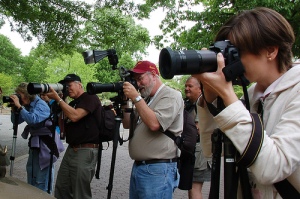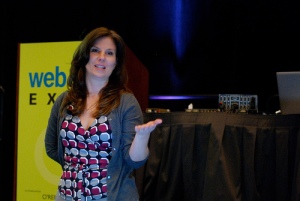For many, the lines between advertising, marketing, and public relations seem blurry. Unless you have personal experience in these fields or close connections with someone who does, these three entities can remain vague. So, hopefully this article will help to dissipate some of that confusion, at least in the area of Public Relations. 
I interviewed Gary Kimler, who is the Public Relations Director at Southeastern University, where I am a student in Lakeland, Florida. He was very gracious, and took nearly an hour out of his day to thoroughly answer all my questions in a face-to-face interview. I would never have guessed how much there is to public relations. It is not an easy job by any stretch of the imagination, but if done well it can be very rewarding.
According to Kimler “no week looks the same.” Last week from March 8th to the 10th was the “craziest week of the year” for him. Southeastern held their 2011 Leadership Forum. The speakers  included a wide array of professional businessmen and women, great influencers in the realm of politics, as well as well-known pastors and heads of ministries. Names that drew the large crowds were Franklin Graham, Anne Beiler, Condoleezza Rice, and George W. Bush.
included a wide array of professional businessmen and women, great influencers in the realm of politics, as well as well-known pastors and heads of ministries. Names that drew the large crowds were Franklin Graham, Anne Beiler, Condoleezza Rice, and George W. Bush.
Kimler was in charge of all the media that covered the event, as well as overseeing the extra photographers, hired by Southeastern. At the end of each day of the three-day event, Kimler was the one responsible for sending out a press release that went to PR Newswire. In the final analysis everything got done, and the event was a huge success but not without a ton of work. 
But, Kimler is not a stranger to hard work. He was a writer for five years at the Tampa Tribune and then another five years at the Lakeland Ledger. So when he accepted the position of Public Relations Director at Southeastern he was stepping into a different role. Yet, he said it was not hard to make the adjustment; there was nothing that really surprised him when he started. He has been able to tie a lot of his past work experience into his new job.
In fact, his college degree in journalism and his writing and reporting experience with the Tribune and Ledger have served him well in this key SEU position, writing press releases, communicating with reporters, and producing Southeastern’s 75th Anniversary Tabloid. He says this publication, commemorating Southeastern’s 75th year, is his most prized piece of work, as head of PR. Kimler was the one assigned to write, research, and design the tabloid written in honor of this important milestone.
 According to Kimler, writing plays a big role in public relations, whether it is writing a press release or a statement from the president of the company. However, this former reporter does not see PR as being unique in using the written word. He said, “I think anyone in any business needs to be a good communicator.” With that comes responsibility to tell the truth.
According to Kimler, writing plays a big role in public relations, whether it is writing a press release or a statement from the president of the company. However, this former reporter does not see PR as being unique in using the written word. He said, “I think anyone in any business needs to be a good communicator.” With that comes responsibility to tell the truth.
When asked if there is anything he would pass on to young people just starting in the field he said, “One area I would pay a lot of attention to is social media. You need to be aware of it and how it can contribute. Also young people need to know the importance of trust — they need to be ethical and honest and never compromise their ethics or the media will take them apart.”
He continued by explaining that if a company tries to hide the truth, and later it is uncovered, the media will come down hard. Everyone will know what your business did. So when the media gets wind of something that is not going to show the organization in the best light and they call you asking for information Kimler said, “Get it all out at the same time.” 
Don’t say a little, and then risk a lot more being discovered in a few days or weeks. If bad news trickles out it means the company reappears in the news again and again, but if it is all released in one shot it may not be good, but it will be less damaging in the long run. Kimler also brought up the point that being honest is simply the ethical thing to do, and he is committed to never compromising his ethics.
Finally, when asked what he does to stay current in the PR industry, Kimler said, “I read Barbara Nixon’s blog.” However, he did not single out himself as being the only one who should have an understanding of public relations. “Every employee in every organization is in Public Relations.” His point here is that one person cannot set the tone of a whole organization, company, school, or business.
Wow, what a great point! Kimler really seemed to have a handle on Public Relations, and he was a great help to me. I feel after my interview with him a lot of things are clearer. I have a better grip on PR and what it looks like as a profession, and it seems a little less intimidating than it did before. 
I was primarily surprised by the amount of ethics involved in this field. I told Kimler that I was not particularly thrilled about the idea of going into an occupation that involved so many ethical decisions. Yet, he pointed out that any field I go into is bound to have some level of challenge in this area. So in the long run, I believe I am more likely to pursue a career in PR, as a result of my interview with Mr. Kimler.
 to address, may go more smoothly, if you’ve considered some professional strategies. Possibly you have been asked by other employees to speak to one of the men or women on staff about their body odor; or maybe it is somewhat simpler like inquiring why someone has been late three days in a row.
to address, may go more smoothly, if you’ve considered some professional strategies. Possibly you have been asked by other employees to speak to one of the men or women on staff about their body odor; or maybe it is somewhat simpler like inquiring why someone has been late three days in a row. 2. When you go to have a difficult conversation with someone pull him or her aside; don’t do it where others can hear and the individual could experience further embarrassment. Also get straight to the point and don’t try to put the blame on others, when explaining why a certain decision was reached.
2. When you go to have a difficult conversation with someone pull him or her aside; don’t do it where others can hear and the individual could experience further embarrassment. Also get straight to the point and don’t try to put the blame on others, when explaining why a certain decision was reached.























